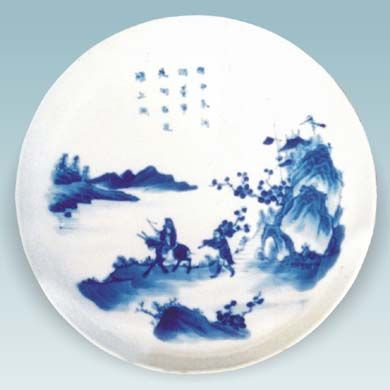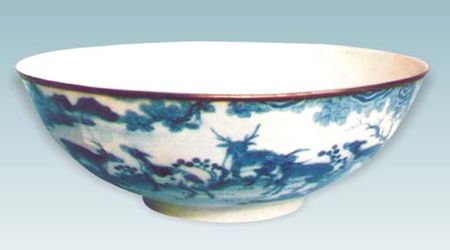An tribute to his father.
The ancestral temple of the Dang family younger branch was created for Dang Van Trong. Therefore, Dang Huy Tru commissioned some vessels to pay homage to his father, the Ancestor of his branch.
The everted bowl1 is design to offer water on the ancestors’ altar. The decor shows a landscape in winter with five axis (deers) under a pine tree. Five inscriptions were written next to the drawing: Dông mach tu co tung, “Winter rain is (at the origin of) the gathering under the solitary pine”, and on the mark only the Dông mach co tung, “Winter rain solitary pine”. The winter represents the old age, the pine symbolises longevity, or even immortality in the presence of rocks (explaining its name “essence of rock”). The images pine and deer were used to express the same message as the previously. But this interpretation is enough. We must take into consideration the presence of the five deers, which express a specific meaning. For this time, Dang Huy Tru left the rebus system hint at the literary hero who became a symbolic. The five deers refer to the five renowned sons of Dau Vu Quan, a Chinese duke living in the Song period, and quoted in the Sanzijing (“Book of the sentences with three characters”). The five deers represent an illustrious progeny. Tran Dinh Son suggests that the five deers represent the five members of the Dang family who became high commissioners, namely Dang Huy Tru, his uncle Dang Van Hoa, his cousins Dang Huy Ta and Dang Huy Xan (sons of Dang Van Hoa) and Dang Huu Pho (grandson of Dang Van Hoa). I cannot agree with this proposition because Dang Huu Pho, born in 1854, was too young to be an official in 1868. The pine in this decor represents Dang Van Trong who survived after his death thanks to the illustrious sons who perpetuated his worship.
Its parallel is a tea service that only subsists the dish2. The plate is decorated with a mountainous river landscape in winter; a high dignitary riding a horse, followed by his servant holding a branch of prunus, leave an important estate to head toward the forest; some prunus blossoms emerged3. In this case, design and the action depicted both contribute to the signifier message. To understand the design, we must carefully consider the action depicted as well as the image. The plum (or prunus-tree) is a winter tree whose blooming intends uprising spring. Its resistance to the cold weather and its early flowering made the prunus the symbol of the right-mindedness and the invincible character. Its flowers had inspired a lot of famous poets; therefore, the expression dap tuyet tam mai, “tread on snows in search of prunus”, to symbolise “in search of a subject of inspiration”. Dang Huy Tru was contented to note tuyet mai, “snow and prunus”, on the mark.
 Above this painting, a poem was written:
Above this painting, a poem was written:
“Tuyet trung vi van dieu canh su,
Tien cu bach hoa dau thuong khai”
(“In midwinter, giving up my official works4,
I compose a poem about the prunus, first flower among the hundred flowers to bloom”).
This poem could be considered like the author's autobiography. With this mission unfinished, he preferred to write and publish his writings just as says the poem. But, a dignitary should not confess such a lapse from duty. So, this decor is only a tribute to his father, a scholar who preferred to open a private school in his village and teaching there, than an official carrier. Let’s quote that, in summer 1868, Dang Huy Tru had also published a compilation of his father's texts, Dang Dich Trai ngon hanh luc.
The choice of the titles, tuyet mai and dong mach co tung, explains the author's desire to associate the two decors. Indeed, the ideogram mach, "rain", in dong mach, writes itself with the ideogram tuyet, "snow" and the ideogram mach for the pronunciation; the winter rain can be assimilated to snow. The association of the prunus and the pine is obvious for a scholar since the prunus, bamboo and the pine are considered as the Three Friends of the winter, because the three trees keep green in the cold season and are therefore frequently gathered. Thus, dong mach co tung, "rain of winter (snow) solitary pine", and tuyet mai, "snow prunus", represents a comparable idea.
1 Bowl, China, Guangdong, 1868, porcelain in underglaze cobalt-blue, H. 8 cm, D. 21 cm, Ho Chi Minh city, Museum of Vietnamese History, gift of Vuong Hong Sen, reprod. Tran Dinh Son & Hoang Anh, op. cit., pl. XXXIII-a.
2 Plate, China, Guangdong, 1868, porcelain in underglaze cobalt-blue, H. 2,50 cm, D. 16,50 cm, Ho Chi Minh city, collection Tran Dinh Son, reprod. Tran Dinh Son & Hoang Anh, op. cit., pl. XXXV-b.
3 This literary decor was very appreciated by the Vietnamese scholars in mission in China and appeared frequently on the “Blue of Hue” often accompanied by a diptych.
4 Literally, “my prime minister works”.

/https%3A%2F%2Fprofilepics.canalblog.com%2Fprofilepics%2F1%2F0%2F100110.jpg)
/https%3A%2F%2Fstorage.canalblog.com%2F14%2F43%2F119491%2F72311865_o.jpg)
/https%3A%2F%2Fstorage.canalblog.com%2F02%2F88%2F119491%2F71838020_o.jpg)
/https%3A%2F%2Fstorage.canalblog.com%2F81%2F99%2F119491%2F64385784_o.jpg)
/https%3A%2F%2Fstorage.canalblog.com%2F71%2F64%2F119491%2F50041969_o.jpg)
/https%3A%2F%2Fassets.over-blog.com%2Ft%2Fcedistic%2Fcamera.png)



/https%3A%2F%2Fstorage.canalblog.com%2F05%2F64%2F119491%2F115101154_o.jpg)
/https%3A%2F%2Fstorage.canalblog.com%2F15%2F21%2F119491%2F115101105_o.jpg)
/https%3A%2F%2Fstorage.canalblog.com%2F42%2F30%2F119491%2F115084175_o.jpg)
/https%3A%2F%2Fstorage.canalblog.com%2F50%2F11%2F119491%2F115083706_o.jpg)